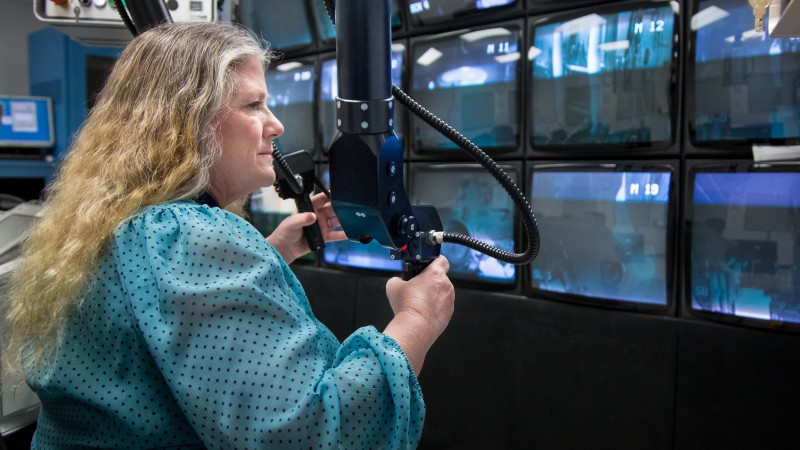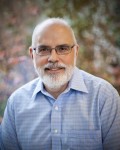Researchers from around the world travel to the Department of Energy’s Oak Ridge National Laboratory to use neutrons at the laboratory’s Spallation Neutron Source for materials science experiments. But they could not succeed without the hard work of operators like Linda Farr behind the scenes.
As technical manager of the remote handlers at SNS, Farr leads a team responsible for monitoring and replacing the accelerator facility’s essential equipment using robotic technology. These contributions ensure safe, efficient operation of the accelerator, which allows scientists to focus on their experiments.
“I schedule SNS’s remote handling–related maintenance and oversee projects to ensure that the entire facility continues to function as it should,” she said.
SNS generates neutrons by propelling protons down a linear accelerator. When the protons collide with the mercury target a “spall” of neutrons is created. The neutrons are then corralled into beam lines and sent to adjoining instruments for research. More than 1,800 researchers used these neutrons in 2016 to reveal details about the nature and characteristics of materials for applications in energy, technology, medicine, and industry.
The spallation process causes the target module and surrounding equipment to become highly radioactive, and the equipment cannot be handled directly by workers—thus the need for remote handling.
“Remote handling is essential to performing both routine maintenance and other necessary activities to support SNS operations,” said ORNL Research Accelerator Division Director Kevin Jones.
The remote handling system includes servomanipulators or dexterous robotic arms. With the help of artificial “fingers,” the servomanipulators can also operate wrenches and other manual tools to examine irradiated equipment from a safe distance. The team also has a crane capable of lifting 7.5 tons at its disposal.
Farr manages all these components from the control room, where she views the work area through strategically placed video cameras, a setup not unlike a real-life video game.
“Linda functions a lot like the conductor of a high-quality orchestra,” said Jones. “Not only does she write and follow instructions—the music—and organize the equipment—the instruments—she also manages various operators—the musicians—to create a masterpiece.”
Farr strives to keep SNS running at peak performance by preventing potentially costly and time-consuming disruptions. If such circumstances do arise, she must mitigate issues and respond to unexpected obstacles in a timely manner.
Because most of the remote handling equipment is unique and complex, the team has little room for error. Target Team Leader John Denison said that Farr “can very quickly ascertain what tasks are necessary and in what order they need to be accomplished.”
Twice a year Farr oversees target change outs that entail strict protocols and safety measures. She collaborates with the target team to examine used targets and gain insights for performance improvements in the future. These responsibilities require a deep understanding of the target environment—known as the target service bay—and its capabilities.
“We cannot overlook any detail,” Farr said. “We must be ready to adapt to any challenge related to the target’s operation.”
These tasks depend on transparent and efficient communication among the remote handlers, engineers, research mechanics, operators, and other groups and individuals under Farr’s direction.
“Linda’s management style promotes a strong degree of teamwork,” Denison said. “I am often amazed at how they get work done with seamless understanding and proficiency.”
In her 29 years at ORNL, Farr has worked in various labs and held a wide array of responsibilities for unique projects. For example, she helped separate actinium, a medical isotope, from thorium, which contributed to advancements in certain cancer treatments. Her group was honored with a UT-Battelle award for this accomplishment.
Farr pursued her current role because of her interest in neutrons and the dynamic environment at SNS, where her work continues to be a cornerstone of this enterprising facility.
“The work can be challenging, but it’s a lot of fun,” she said. “It’s the sort of thing I never thought I would be doing.”
In her spare time, Farr enjoys making stained glass, cross stitching, and spending time with her grandchildren.
Her experiences as a woman in a male-dominated field bolstered her confidence in her abilities, prompting Farr to encourage other women pursuing work in STEM fields.
“My advice is simple: If it’s something you enjoy, don’t let anyone scare you off.”
SNS is a U.S. Department of Energy Office of Science User Facility. UT-Battelle manages ORNL for the DOE Office of Science. The Office of Science is the single largest supporter of basic research in the United States and is working to address some of the most pressing challenges of our time. For more information, please visit http://science.energy.gov/.—by Elizabeth Rosenthal




